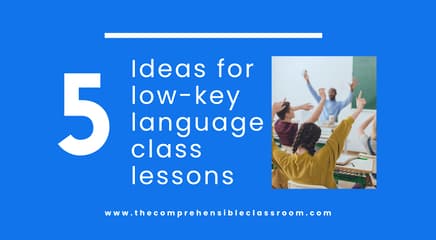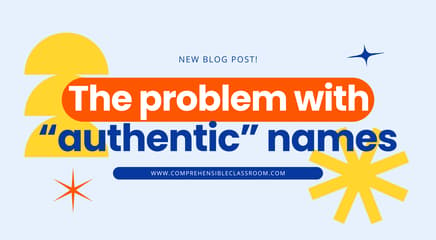Waaaaay back when I was a baby language teacher, I attended a writing workshop for world language teachers here in Anchorage. Dr. Amy Wright, then-professor at the University of Alaska-Fairbanks walked us through a powerful strategy to personalize and break down a complex text.

In Dr. Wright's workshop, we worked with an excerpt from La casa en la calle Mango (The House on Mango Street) by Sandra Cisneros, and it was easy to see that students would be very comfortable and profoundly familiar with the text by the time that they had completed the series of tasks–even if the text itself was not entirely comprehensible to them.
TEXT SELECTION
In the demo, we worked with a translated version of El hombre feliz, which is an incredibly complex text. The best texts to explore through Text Discovery are fairly evocative; with interesting language and great imagery. Even more important than the language are the themes of the text: choose one that plants ideas that your students can relate to or have opinions about. Try using song lyrics, poems, short stories and excerpts from longer authentic texts; even a news story could work!
TEXT DISCOVERY STEPS
The full activity contains eight steps, and I have found that each one of them has value as a stand-alone activity. Depending on text complexity, time constraints, and instructional goals, you might choose 1-4 steps to walk through with a single text instead of tackling all seven. As you read through these steps, consider how you might use each one individually in your classes!
STEP 1: FOCUSED FREE WRITE
Give students two or three writing prompts that will allow them to explore the themes of the passage. Allow them two minutes to do a focused free write for each prompt!
STEP 2: SHARE WRITING
In groups and seated in a circle, have each students choose one of their prompt responses to read aloud to the others. You could tell students which of the 2-3 responses to read aloud, but I like giving them the option to choose so that the activity can feel more 'safe'. I would also recommend giving students the option to not read aloud a prompt if they don't feel comfortable doing so!
In a comprehension-based classroom, consider approaching this step through class discussion instead! Discuss the questions planted by your prompts as a class instead of having students lead with output.
STEP 3: READ AROUND
With students still seated in a circle, read the text aloud together. This can be done with each student reading a sentence, taking turns in order around the circle or doing a popcorn reading. Alternatively, you can give the text a completely different feel by asking each student to read a LINE of the text as printed on the page, even if the thought or sentence is incomplete when the turn changes.
STEP 4: HIGHLIGHTS
Read the text aloud to your students or ask one of your students to read it aloud for everyone to hear. This time, as students listen they must underline any word, phrase, or sentence that stands out to them. They might stand out because students like the way they sound, because they plant an interesting idea, because there is a personal connection..or just because!
STEP 5: DISAPPEARING VOICES
With all students following along on their copies of the text, the teacher or a student will read the entire text aloud again. It is important for the Reader to read at an even, not-too-fast, not-too-slow pace.
As the Reader reads the text, he or she will be periodically joined by the other students. Students will join in the Reader anytime that he or she reads something that they highlighted as a standout phrase. In this way, the class will always hear the voice of the reader, but sometimes there will be other voices that join in. If a student underlined 10 words, phrases, or sentences in the text, that student will "cut in" and read aloud each one of those 10 words, phrases, or sentences along with the original Reader, then "cut out" as the Reader continues to a portion of the text that was not marked by the student.
STEP 6: COLLECTIVE POEM
If students underlined more than two things, have them choose their two favorites: the two things that stood out to them the most from the text!
Use those two standout phrases to do another read-around. Instead of reading the full text, students will be reading their phrases. Pick one student to launch the read-around by reading aloud one of the two words, phrases, or sentences that stood out to them the most. Continue clockwise around the circle until every student has read one of their standout items, then go around the circle again so that students read the second item.
Emphasize that they should not change the phrases that they selected if someone else reads it first; the repetition is important! The result will be a collective poem of sorts, created by and unique to the group.
STEP 7: FOCUSED FREE WRITE
It's time for another focused free write! Have them choose one of the two standout items that they just chose and expand on it for two minutes in writing. They should write anything that comes into their heads when they think about that phrase; à la stream of consciousness.
Ideally, this focused free write would be done in the target language. I think you could explore the possibility of allowing it to be done in English, too. If you try it out, let me know your thoughts!
STEP 8: INTERRUPTING READ-AROUND
Finally, do another read-around. This time, either you or one of your students will read the entire passage aloud. As that person reads, he or she will be regularly interrupted by other students in the class. Whenever the reader reads aloud the word, phrase, or sentence that served as a writing prompt for a classmate, that student will interrupt him or her.
For example, consider this text:
Mary had a little lamb, its fleece was white as snow. And everywhere that Mary went, the lamb was sure to go.
READER: "Mary had a little lamb, its fleece..."
STUDENT 1: "Fleece rhymes with Greece, Greece reminds me of my grandfather. He was Greek..."
READER: "...was white as snow..."
STUDENT 2: "Snow around here isn't all that white. It gets dirty so fast. It's only pretty for like...what? An hour? Until the plows come through. And watch out for yellow snow!"
READER: "...And everywhere that Mary went, the lamb..."
STUDENT 3: "My mom makes lamb every Passover and I have to say, it's gross. Not my favorite meat at all. Plus...LAMBS! They are so cute and innocent. Blecht. Not my favorite meal at all."
READER: "...was sure to go."
If multiple students wrote from the same phrase, there will be a chain of tangents. After the interruption is over, the reader continues until he or she is interrupted again.
STEP 9: REFLECTION
Wrap up the activity with a conversation about the experience! What themes and questions emerged? What surprised students? What emotions did they experience?
Depending on your students' level of proficiency, you might be able to do this in the target language. If not, I think there is value in having this conversation even if it needs to happen in English!
KEEP IT COMPREHENSIBLE
As presented, Text Discovery was very output heavy. Since attending that workshop, I have explored how to modify the plan as presented in order to transform it into a comprehension-based activity; specifically, how to use it with Novice language learners through the use of Embedded Reading (see El hombre feliz unit for Spanish II as an example).
TEXT DISCOVERY DEMO
In April of 2019, we walked through Text Discovery in our NYVTy PLC so that you could see it modeled. Watch our demo to see three steps of the process:
DEMO: Watch three steps from the Text Discovery process!
CREDIT
Dr. Amy Wright, a former professor at the University of Alaska-Fairbanks, modeled this strategy at a free writing workshop for world language teachers in Anchorage as a tool to explore literary texts in 2009 or 2010. She called it "Literature Circles", and I have changed the activity name so as not to confuse it with another, more common reading activity with the same name.





